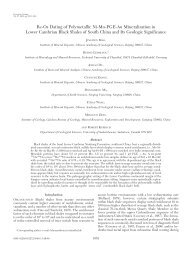Uranium Ore Deposits
Uranium Ore Deposits
Uranium Ore Deposits
You also want an ePaper? Increase the reach of your titles
YUMPU automatically turns print PDFs into web optimized ePapers that Google loves.
WEITERBILDUNG<br />
related deposits in Canada during the 1960s, and of veryhigh-grade<br />
deposits up to around 20 % U in the same setting<br />
in the 1980s changed the economics of uranium. Nevertheless,<br />
there are currently still many low-grade and very-low<br />
grade (< 0.05 % U) deposits profitably mined, either due to<br />
cheap extraction techniques (such as in-situ leaching) or<br />
due to co-production of copper and gold (such as in IOCG<br />
deposits). Figure 6 gives an overview of the more important<br />
mineralization styles in terms of tonnage and grade. The<br />
high end in terms of grade is represented by unconformity-related<br />
deposits, the low end by paleoplacers and the<br />
giant Olympic Dam IOCG deposit in Australia.<br />
Three major types of hydrothermal uranium ore deposits<br />
provide about 85 % of the present-day world uranium<br />
mine production. These are (1) unconformity-related uranium<br />
deposits, (2) sandstone-hosted or „roll front“ deposits,<br />
and (3) IOCG („Iron Oxide-Copper-Gold) deposits. All three<br />
types form at redox fronts where oxidized basinal brines<br />
or meteoric water meet reducing lithologies or methanebearing<br />
fluids. The basic process is large-scale leaching<br />
of U 6+ from average or slightly uranium-enriched rocks<br />
under oxidizing conditions, and fixation in the U 4+ state (uraninite;<br />
UO 2<br />
). This ore formation requires large amounts of<br />
oxidized warm water, such as available in intracratonic basins<br />
with km-thick sequences of red sandstone (±gypsum).<br />
Large-scale fluid circulation can leach both<br />
the sedimentary basin sequence as well as the underlying<br />
metamorphic basement.<br />
The reduction can be achieved by interaction of such<br />
water with reduced lithologies (for instance, graphite<br />
schist) or with hydrocarbons. The textbook example for<br />
this situation is the Athabasca basin in northern Saskatchewan,<br />
Canada, where several large mines work (or are<br />
developed to mine) ore with up to 20 % U (McArthur River,<br />
Cigar Lake) (Fig. 7 and 8).<br />
These high-grade deposits occur near the unconformity<br />
of the Archean to Paleoproterozoic metamorphic basement<br />
and the overlying 1.9 Ga-old Athabasca sandstone, and are<br />
therefore commonly termed unconformity-related uranium<br />
deposits. The uranium mineralization is spatially associated<br />
with sheared graphite-bearing meta-sedimentary units<br />
in the basement, which have transmitted their reduced<br />
environment via hydrothermal halos into the overlying<br />
sandstone (Fig. 9). This control is important for exploration<br />
of hidden ore bodies by electrical geophysical methods.<br />
A similar example are the classical sandstone or rollfront<br />
deposits in the western USA where uranium is concentrated<br />
in sandstone aquifers where the lithology changes<br />
from oxidized to reduced (Fig. 10).<br />
Fig. 6:<br />
Grade versus tonnage plot of<br />
major uranium deposits. Data<br />
form many sources. Note that<br />
pre-mining data vary depending<br />
on economic and geological<br />
assumptions. Geographic allocation<br />
of the deposits identified by<br />
name: Canada (McArthur River,<br />
Cigar Lake, Collins Bay, Key Lake,<br />
Midwest. McClean Lake, Quirke<br />
Lake), Australia (Nabarlek, Ranger,<br />
Jabiluka, Yeelirrie, Olympic Dam),<br />
Congo (Shinkolobwe), Czech Republic<br />
(Pribram, Rozna), Germany<br />
(Aue/Niederschlema, Zobes,<br />
Ronneburg, Menzenschwand),<br />
France (Fanay), Russia (Streltsov),<br />
Kazakhstan (Mynkuduk, Inkai),<br />
Namibia (Langer Heinrich, Rössing),<br />
South Africa (Welkom, West<br />
Rand).<br />
Ausgabe 02 | 2008<br />
www.advanced-mining.com<br />
20










